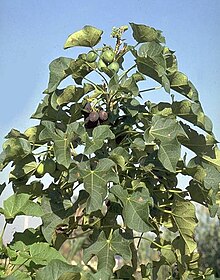Fences for Fuel
Fences for fuel ( English original name " Fences for Fuel in Virat Nagar Block, Jaipur, India" ) is a development aid project of the non-governmental organization Humana People to People , which is carried out in the area around the Indian city of Jaipur .
The project was on 9 May 2006 with a price of World Bank ( "World Bank Development Marketplace-2006") for "Innovative projects in the field of water supply , sanitation and energy supply for people in poverty " ( "Innovative projects within Water, Sanitation and Energy services to poor people ”). It started in August 2006 as the Virat Nagar community development project.
Project background and goals
Implementing a comprehensive plan for using the physic nut ( Jatropha curcas ) aims to provide an alternative source of fuel and create environmental benefits for farmers.
The livelihood of the rural population in Rajasthan , India is heavily dependent on natural resources and climatic conditions. The effects of deforestation , drought and soil erosion on the environment are the main factors that compel many in search of better opportunities in the poorest regions migrate to the cities. At the same time, smallholders and other marginalized people contribute to the weathering of the soil by cutting down trees for firewood . The drought-resistant perennial jatropha can thrive in poor soils and alleviate many of these problems.
“Fences for Fuel” integrates several components that ensure a sustainable way of life for smallholders and for the land that feeds them. The oil from the seeds of the physic nut provides renewable energy . At the same time, hedges made from these plants help improve the soil and limit erosion .
The project works with farmers' associations in 40 villages with 400 smallholders. It is designed to help them improve their livelihoods and preserve the local environment by setting up living jatropha fences around gardens and fields. The project uses a model to show the smallholders practical examples of planting and maintaining jatropha fences and of producing oil and bio-diesel. Humana area workers distribute the plants to the farmers. A production plant extracts bio-diesel from the vegetable oils for its own consumption and sale. The by-products of the plant also contribute to the villagers' income .

The plant
The physic nut ( Jatropha curcas ) is a slightly succulent, drought-resistant shrub or tree up to 8 meters high that is traditionally used for living fences, especially in America and Africa, as animals do not eat it because of its toxic sap. It has a lifespan of up to 50 years. It can be raised from seeds, saplings or cuttings. Its nutty seeds, which are poisonous for humans and many animals, contain 30–50% oil depending on the variety.
Oil extraction
Up to 9 kg of seeds can be harvested per adult tree and year, or 2 to 5 t per hectare in cultivation. After roasting or cooking, your oil can be extracted to 75–80% with hand-operated mechanical oil presses ( see: decentralized oil mill ). 5 kg of seeds make around 1 liter of oil. The press cake can be used as fertilizer. Because of the insecticidal properties of the toxins it contains, it can reduce nematode infestation in the soil.
use
When filtered, the oil of the physic nut seeds can be used in various ways:
- as fuel for cooking areas;
- for lighting: in converted kerosene lamps or jam or drinking glasses with a floating wick;
- for the production of bio-diesel;
- to obtain a well-foaming, white, skin-friendly soap.
Older, strong branches of the plant can be used as permanent supports or posts as they are less likely to be infested by termites.
"Fences for Fuel" in Africa
Another project of this kind was initiated in 2005 by the HUMANA partner organization ADPP in Mozambique . It works together with students from the two teacher training centers of ADPP, EPF Chimoio and EPF Nhamatanda and is supported by the Swiss and US NGO "The GAIA-Movement Trust Living Earth Green World Action".
In 2006, the HUMANA partner organization DAPP Zambia, together with the GAIA Movement, initiated a biofuel project in Children's Town Malambanyama in the Chibombo district in Zambia . It is financed by the GVEP Global Village Energy Partnership, the World Bank and the “Pumps for Trees, Chibombo” project.
swell
Web links
- "Jatropha for Fencing and Oil" (PDF, 5 pages, English; 116 kB)
- Biodiesel project in Zambia (PDF, 10 pages, English; 583 kB)
